
Kembra Pfahler of The Voluptuous Horror of Karen Black onstage at The Queen Elizabeth Hall during Meltdown Festival. All live photos by me
New York glitter-punk outfit The Voluptuous Horror of Karen Black began life as a near-death experience. Shortly before forming the band in 1990, front woman Kembra Pfahler was strangled in a brutal mugging and almost died. While recovering, battered and zonked on painkillers, she watched the 1975 horror movie Trilogy of Terror on television. The film stars Karen Black, the quirky cross-eyed actress whose wildly erratic career encompasses everything from some of the key American films of the 1970s (Easy Rider, Five Easy Pieces, Nashville, Day of the Locust) to mainstream Hollywood schmaltz (Airport 1975) to obscure straight-to-VHS exploitation/horror dreck. In Trilogy of Terror’s best known segment, Black is stalked by and eventually possessed by a cursed malevolent Zuni fetish doll which has come to life.
* SPOILER ALERT * It concludes with a final jolting image of the now-crazed and murderous, knife-wielding Black grinning blank-eyed and maniacal to the camera to reveal a mouthful of razor sharp teeth identical to the Zuni doll’s.
Karen Black in Trilogy of Terror (1975). You can watch Trilogy of Terror in its entirety on Youtube here
(Later, when asked about the significance of Karen Black Pfahler would reply, “She’s a very compelling cinematic figure,” keen to emphasise the name is an homage and not intended as satirical or ironic. Karen Black herself is ambivalent about the band).
In her traumatised state, that savage and disturbing image -- combined with almost dying-- made a powerful impression on Pfahler. Inspired, she would blacken-out her teeth, conceal her natural fine-featured beauty under cadaverous make-up and take to the stage clad in little more than a pair of thigh boots and a coat of body paint. Pfahler’s look can suggest a character from a John Waters film given an “ugly make-over”: think of Divine as the acid-scarred Dawn Davenport in Female Trouble (1974), an image which seems to anticipate TVHKB’s twisted glamour. Like Divine before her, Pfahler shaves off her eyebrows and shaves back her hairline to accommodate her extreme eye make-up. “I want to be both very beautiful and very repulsive,” Pfahler would explain to The Toronto Star in 1994.
Pretty, pretty? Divine as Dawn Davenport in the 1974 John Waters film Female Trouble
Pfahler’s minimalist dress code would appear to be informed by LeRoy Neiman’s Femlin cartoons from 1950s Playboy magazines
In the great tradition of husband and wife-fronted punk bands like Lux Interior and Poison Ivy (The Cramps), John Doe and Exene Cervenka (X) and Jon Spencer and Cristina Martinez (Boss Hog), Pfahler formed TVHKB with her then-husband and artistic collaborator Samoa Moriki (who’s from Hiroshima; he invested his knowledge of Noh and Kabuki theatre into TVHKB). Before forming TVHKB the duo had concentrated on performance art and making their own no-budget Super 8 experimental films together (described as “surrealistic fetish films”). Pfahler also appeared in films by key Cinema of Transgression auteurs Nick Zedd(War is Menstrual Envy, 1992) and Richard Kern (Sewing Circle, 1992). Like Catherine Ringer of French art-punk band Les Rita Mitsouko, Pfahler dabbled in specialist hardcore porn, playing dominatrixes in wrestling-themed fetish films. Legendary underground filmmaker George Kuchar (or his brother Mike Kuchar, depending which account you read) had already described Pfahler and Samoa’s art work as “voluptuously horrific” – hence the name.
This may all sound quite macabre or Goth, but TVHKB is in fact a scream: think of them as in the tradition of bands for which every day is Halloween (Alice Cooper, The Cramps, Siouxsie and the Banshees) crossed with a theatrical troupe / carnival freak show. Their songs are joyously trashy and campy, powered by the towering, ominous hard rock riffs of virtuoso guitarist Samoa (who’d previously played in a Japanese rockabilly band and sometimes cross dresses), over which Pfahler belts out her mordant lyrics (about subjects like alien abduction and plastic surgery) in a grating, bratty sneer (like all the best punk vocalists, she sings just well enough).
TVHKB’s cheap’n’cheerful infamous live shows, with each song a performance piece involving kitsch no-budget cardboard props and loadsa nudity, recall everything from The Addams Family and The Munsters to the cinematic oeuvre of Ed Wood Jr (a relevant comparison, considering Pfahler is surely the spiritual daughter of his Plan 9 from Outer Space leading lady Vampira). “It’s a demented school play,” is how Pfahler defined their stage shows to The Chicago Tribune in 1994.
"Mr Twilight" video from TVHKB's debut album A National Healthcare (1993). Who could resist that black-toothed smile?
Commanding attention at the centre (flanked by her semi-naked, body-painted showgirls, the Blackettes) is Pfahler, whose decaying glamour ghoul image is incredibly vivid. Her signature look – simultaneously seductive but repellent - is timelessly weird and alluring. It can evoke everything from killer zombie, to Linda Blair in The Exorcist, to voodoo doll or devil girl, to one of LeRoy Neiman’s Femlin cartoons, to horror movie scream queens (not just Karen Black, but Barbara Steele), to the sexy blue or green-skinned alien chicks that Captain Kirk used to make out with in 1960s episodes of Star Trek. “We try to concentrate on fun – the glamour, the pageantry. We like to think of ourselves as Ann-Margret, the glamour, the simplicity,” Pfahler told The Chicago Tribune in 1994. Indeed Rolling Stone would call Pfahler “a cross between Ann-Margret and Elvira.” Certainly Pfahler’s daintily mincing sex kitten-gone-berserk / go-go dancer stage moves recall camp icon/sex symbol Ann-Margret at her most wigged-out in the 1975 Ken Russell film Tommy.
TVHKB performing "Underwear Drawer" and "Sick Bed" in New York, circa 1996. They played both of these songs at Meltdown. Note Samoa's pristine platinum blond quiff worthy of Billy Fury
Unlikely as it sounds, long before this, Pfahler (born in 1961 in Hermosa Beach) had been a sun-kissed California girl. Her father was celebrity surfer Freddy Pfahler (he’d appeared in the 1958 surfing film Slippery When Wet) and her family had show business connections. Growing up in Malibu close to the beach, Pfahler’s neighbours included Shelley Winters and Barbara Streisand. As a child Pfahler was a gymnast, modelled and acted in some TV commercials (like Jody Foster before her, she once appeared in a Coppertone suntan lotion ad).
A conventional acting career seemed like a certainty for Pfahler. As an alienated and rebellious teen, though, Pfahler felt stifled by Californian conformity, in particular the narrow conceptions of physical beauty for women. She found solace in the feral Los Angeles punk subculture, then at its height. When she ran away to New York in 1979 aged 17, her imagination was already fired by LA punk (especially Exene Cervenka of X), Diamanda Galas, The Cramps, Lydia Lunch and the No Wave movement. Upon arriving, Pfahler befriended and sang with doomed scatological punker GG Allin. She also had a brief stint of heroin addiction, which she quickly got out of her system.
In the ensuing years after forming TVHKB, Pfhaler established herself as an iconic downtown New York art and music scene figure and a paragon of alternative glamour. The latter was made official in the mid-90s when she was photographed by Steven Meisel for an ultra-hip “heroin chic” Calvin Klein ad campaign, which also featured quintessential rock chick Anita Pallenberg, former Warhol star Joe Dallesandro, Jennifer Herrema of Royal Trux and Theo Kogan of The Lunachicks.
The Voluptuous Horror of Karen Black 'Bring Back The Night' from Bijoux Altamirano on Vimeo.
"Bring Back the Night" from the 2010 album Home of the Brave. The song is not particularly representative of TVHKB’s sound but the video – filmed in Claude Monet's Gardens in Giverny, France – is exquisite. (If you get an error message, refresh the page. The video does work)
(As a side note: TVHKB used to perform regularly at the outrageous, now sadly defunct nightclub Squeezebox!; my old friend Jayne County used to urge me to go to Squeezebox! if I was ever in New York, that I would love it. She almost certainly said it was “faaabulous.” I only managed to make it to Squeezebox! once, in 1999 and it more than lived up to Jayne’s claims. Pride of place on one of the walls was a giant framed photo of Kembra and Marilyn Manson embracing).
TVHKB performing “Shopping Spree” at a gig promoting the documentary Squeezebox! The Movie in 2008
In recent years, though, TVHKB appeared to grind to a halt. I remember reading about Pfahler and Samoa breaking up. (There would be a line-up of TVHKB with Adam Cardone of The Toilet Boys replacing Samoa). Their website is now yanked down and TVHKB’s Myspace page – remember Myspace? – has not been updated since 2010. All three of their CDs are now long out of print and virtually unobtainable. A new CD called Home of the Brave apparently came out in 2010 but seemed to promptly vanish without a trace (just try to order it online!). As a long-term fan (I'd written to TVHKB directly to order their self-released debut CD in 1995, and Samoa wrote back. I still have his letter), I’d always hoped TVHKB would come to London, but it was clearly never to be.
Or was it? Flash-forward to 2012 with the announcement that Antony Hegarty would be the curator of the 2012 Meltdown Festival. His line-up of concerts was bound to be interesting, with the promise of the elite of NYC’s downtown avant-garde (the milieu Hegarty himself had emerged from) coming to London. Sure enough, when Hegarty’s roster of acts was unveiled it included maverick extreme talents like Diamanda Galas, Joey Arias, Marc Almond ... and TVHKB! It looked like they temporarily re-formed just for Meltdown (with Samoa back in the band). My friend Christopher Raymond and I snapped up tickets as fast as we could. I’d given up on ever seeing TVHKB – and now I was!
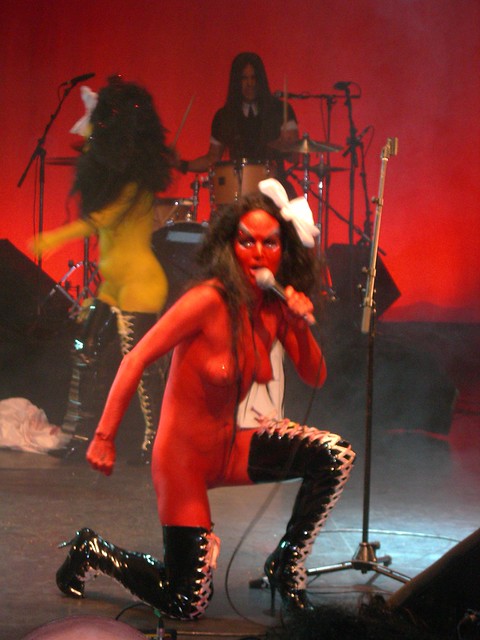
The Voluptuous Horror of Karen Black at Meltdown
The gig on 10 August 2012 was a blast: good-natured, raunchy fun and everything I could have hoped for. Stalking to the stage, Pfahler and her lookalike Blackettes were like walking pieces of freaky art come to life. The band (a stripped-down trio) was awesomely tight, but the show itself was appealingly loose without being shambolic. (Most of the Blackettes were actually local London girls recruited for the gig; the budget obviously didn’t stretch to TVHKB bringing over their regular NYC-based dancers. You could sometimes sense they hadn’t rehearsed quite enough. It only added to the fun). It’s tempting to say they blasted through a 90-minute set of their greatest hits, but TVHKB never actually had any hits, so let’s say their “essential statements” instead: “Am I Blue?” “Neighbourachie”, “I Believe In Halloween”, “Water Coffin”, “Sick Bed”, “Shopping Spree”. Pfahler dedicated “Honky Tonk Biscuit Queen” to Antony Hegarty. For big finale “Alaska” one of the Blackettes pelted Pfahler with white feathers to simulate snow (the feathers stuck to her sweat and body paint; it looked like she’d been tarred and feathered).
The show felt wonderfully like a freaked-out soul revue: think of a perverse, Satanic nightmare inversion of the Ike and Tina Turner Revue in Las Vegas, with Pfahler and Samoa as Tina and Ike, and the Blackettes as the equivalent of their Ikettes. Pfahler’s fright wig (a massive jet black matted punk-bouffant haystack dusted with red glitter) started malfunctioning almost from the start, wobbling and threatening to fall off. Unperturbed, she began tearing clumps of hair from it and hurling it into the audience (Christopher caught a hank of it; bobby pins were still attached to it. Handling it, we both got covered in red glitter). Finally she asked, “Is this really necessary anymore? It’s really hot up here” and continued the rest of the concert wig-less.

Kembra's malfunctioning wig

Kembra and Samoa: The Ike and Tina Turner of punk performance art
The climactic moment was indisputably when Pfahler stood on her head, spread her legs and one of the Blackettes cracked paint-filled Easter eggs onto her vulva. It was a surprisingly solemn moment; it felt primal and timeless, like watching the re-enactment of an ancient Pagan or Mayan fertility ritual. I’d been waiting breathlessly for the egg-cracking segment and it didn’t disappoint. My friend Julian was seated in row B (Christopher and I were in row D) and I told him his view would be gynaecological (it was; and also proctological). Even before TVHKB took the stage, Julian turned to me to point out there was a carton of eggs in the corner of the stage. (Alongside Edith Massey in Pink Flamingos, Kembra Pfahler’s name should forever be associated with the word “eggs”). When one of the Blackettes emerged with a clear plastic tarpaulin and spread it centre stage, Christopher elbowed me in the ribs. It was time...
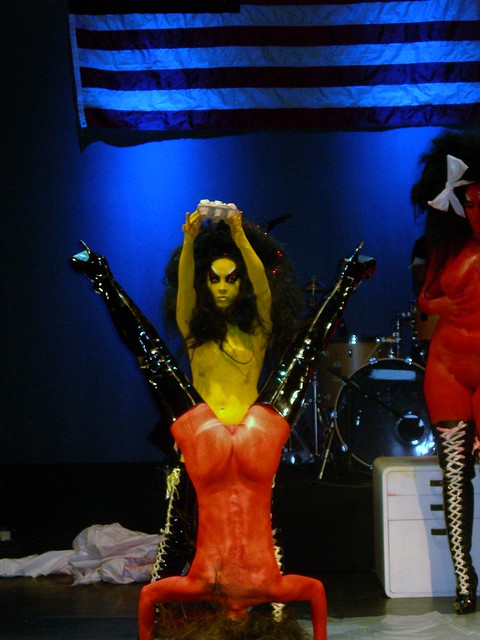
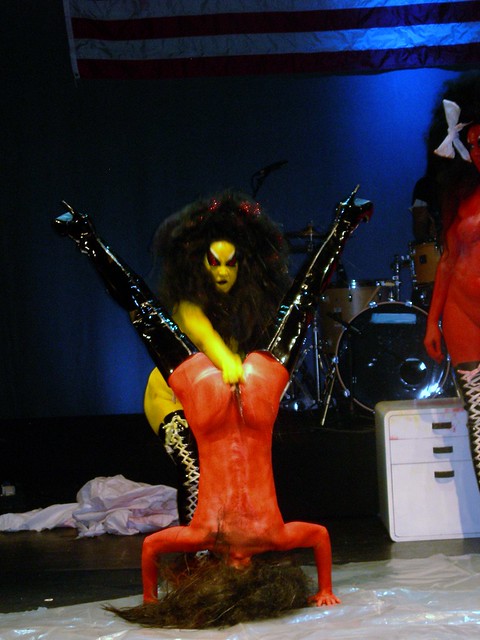

I could kiss whoever filmed this clip and posted it on Youtube. Experience it for yourself!
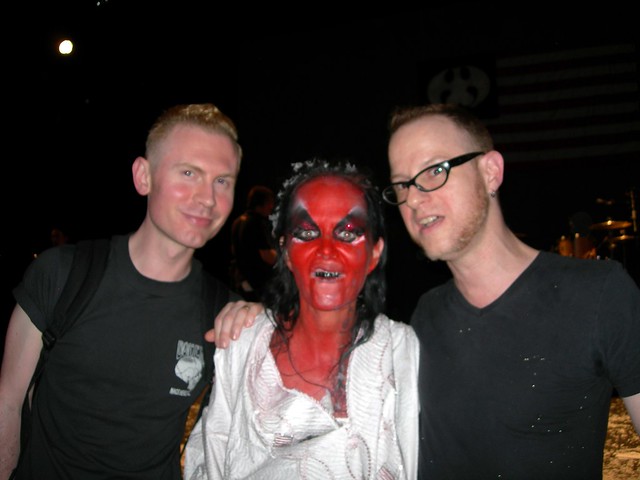
Christopher, Pfahler and I post-show. She was sweetness personified and twined her arms around us for the photo. I told her I’d loved TVHKB since their first CD in the early 1990s and she said, “Yes! We’re still alive.” I told her to come back again to London sometime soon, don’t leave it so long and she replied, “Oh, probably not ...” I think they re-formed just for Meltdown
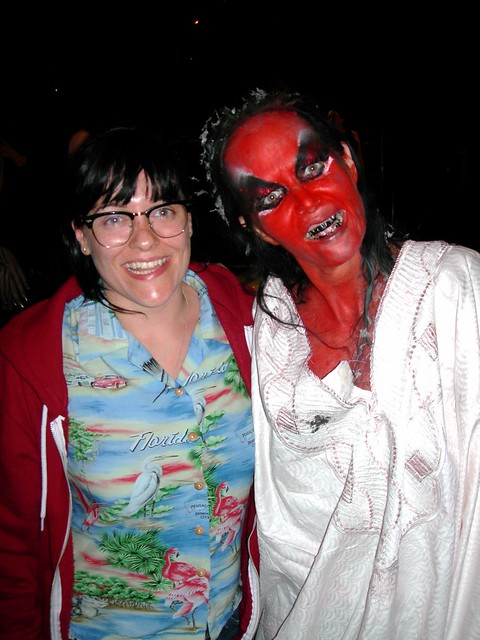
My friend Emma (aka DJ Elma Wolf of Twat Boutique, Club Lesley and Saturday Night Fish Fry) and Pfahler
(It’s essential I mention TVHKB’s opening act, a band called Tenderloin from Berlin. I’d never heard of them before. My friends were indifferent about even checking them out, but I figure we’d paid to see them and they were bound to be interesting at least if they were chosen by Antony Hegarty. We took our seats a few songs into their set, and I was awe-struck to see their lead singer was Vaginal Davis! I’ve long been an admirer of Ms Davis (I swear she used to be called Vaginal Crème Davis, but she must have lost the “Crème” at some point). Alongside Canadian filmmaker Bruce LaBruce, Davis virtually invented the Queer-core (or Homo-core, if you prefer) punk movement in the early 90s and therefore made life one helluva lot more interesting. For anyone unfamiliar with Davis, the self-described "controversial black woman" is a towering African-American drag queen (seriously: he’s built like a brick shithouse), zine writer, punk musician, nightclub promoter and all-round provocateur. Like Pfahler, he emerged from the fertile Los Angeles punk scene (they’ve been friends since the 1970s); in recent years he’s re-located to bohemian Berlin. Anyway, Tenderloin was brilliant: minimalist, strange, stark but danceable, with Davis declaiming lyrics seemingly inspired by the film Christiane F – often in German – in a high-pitched voice, channelling Tina Turner and Whitney Houston in a tousled auburn wig, billowing white mini-dress and killer heels. Mindblowing! And in a foreshadowing of TVHKB, when they left the stage we realised Tenderloin’s fit hottie of a drummer had been playing stark naked the whole time; we’d just assumed he was shirtless! Read an interview with Tenderloin drummer Joel Gibb on the Butt website. Tenderloin is definitely divisive - I loved them, but most of my friends didn’t. But that’s probably true of all interesting bands and artists).
Tenderloin (feat. Vaginal Davis) from Earl Dax on Vimeo.
Brief fragment of Tenderloin performing in Berlin. This gives you a pretty good flavour of their Meltdown performance (Davis is even wearing the same wig and dress combo)
The following day, my friend Emma and I returned to the Southbank to see Pfahler give an intimate, low-key onstage lecture about the concepts and manifestos behind her work, chiefly availabism, anti-naturalism and future feminism. It was pretty sparsely attended (just a handful of devotees). Pfahler was endearingly nervous, she complained of jetlag and her lecture was a bit rambling: “slick” is not in her vocabulary, but slick is overrated. Out of her stage drag and close-up Pfahler is stunningly beautiful with a delicate face, tiny (5’2) and (at 51 years old) eerily ageless. She wore a floor-length white crocheted dress through which was visible her black bra and panties underneath. Her daytime look isn’t exactly neutral or low-key: her heavy black eye make-up was pure Bride of Dracula.
Some of the highlights of Pfahler’s lecture: she discussed onstage nudity and explained she carefully advises her dancers about it first (wearing a g-string is definitely optional). “Going bottomless will ruin your life; no one will ever take you seriously again. You will never get a job,” she cautions them. Asked about her most notorious film Sewing Circle directed by sleaze-meister Richard Kern, in which Pfahler temporarily sews her vagina shut, she explained she was making a statement about re-claiming herself after an abusive relationship. (Funnily enough, in the 1990s I interviewed Richard Kern and we talked about Sewing Circle). An audience member asked her about taking risks and Pfahler replied, “Risk is all I had.”
(As a nice postscript, Vaginal Davis was sitting directly behind me during Pfahler’s lecture, and afterwards we spoke briefly. I told him how much I loved Tenderloin and that I’d been following his work since the 1990s. In fact, at one point in the 90s I wrote to him requesting one of his zines and he wrote back. Davis exuded warmth and sweetness. My next art project is conniving how to get Tenderloin to return to London for another show).
(This nice anecdote from a Guardian article about Hegarty’s Meltdown line-up concisely illustrates Pfhaler’s theory of availabism – using whatever comes to hand for your art: “One day in 1979, a few weeks after her arrival in New York City, artist and musician Kembra Pfahler was invited to perform in a club on the Lower East Side. "I decided I would stand on my head and crack an egg on my vagina," she says with disarming matter-of-factness. "Just because my body was available and I had eggs in the refrigerator.")
"I wanted to be as unpopular as possible ... and that happened." This brief clip (just over three minutes long) offers a great summary of Pfahler’s philosophies and inspirations. It’s also fascinating to see her interviewed in her stark, compact New York apartment (I can’t tell whether it’s a studio or a one bedroom). Every surface is painted the colour of dried blood.
Bonus track! Sadly they didn't perform this at Meltdown, but it's too good not to include. TVHKB give "My Heart Will Go On" (the love theme from Titanic) a savage mauling. It's enough to give a Celine Dion fan a coronary.
Further reading:
See the rest of my photos from the Meltdown gig on my flickr page
At Home with Kembra Pfahler!
Nice thoughtful interview with Pfahler in The NY Times from June 2012
The Voluptuous Horror of Karen Black discography:
A National Healthcare (1993)
The Anti-Naturalists (1995)
Black Date (1998)
The Home of the Brave (2010)



























I love this band and moved back to the US just before their London show.
ReplyDeleteBut what is this "Home of the Brave" you speak of and how oh how do I get a copy???
Home of The Brave is meant to be the last VHKB CD to date. When I was researching this piece, I came across it (for example, the video above for "Bring Back the Night" -- that song is taken from the Home of the Brave album). I've Googled and looked on Amazon and there is no sign of it. It also isn't available on iTunes. Maybe it never got officially / properly released? The label went bust? I'd have to ask Kembra herself! The Black Date CD has also well and truly vanished and I don't think was ever issued in the UK, but it is on iTunes.
ReplyDelete